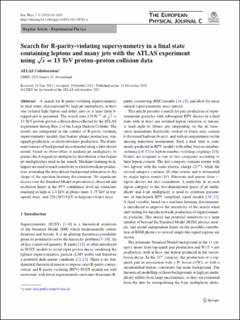Search for R-parity-violating supersymmetry in a final state containing leptons and many jets with the ATLAS experiment using √s = 13 TeV proton–proton collision data
Aad, Georges; Abbott, Brad; Abbott, Dale C.; Abed Abud, Adam; Abeling, Kira; Abhayasinghe, Deshan Kavishka; Abidi, Syed Haider; Abramowicz, Halina; Abreu, Henso; Abulaiti, Yiming; Bjørke, Kristian; Bugge, Magnar Kopangen; Cameron, David Gordon; Catmore, James Richard; Garonne, Vincent; Gramstad, Eirik; Heggelund, Andreas; Hellesund, Simen; Håland, Even Simonsen; Morisbak, Vanja; Oppen, Henrik; Ould-Saada, Farid; Pedersen, Maiken; Read, Alexander Lincoln; Rye, Eli Bæverfjord; Røhne, Ole Myren; Sandaker, Heidi; Vadla, Knut Oddvar Høie; Buanes, Trygve; Djuvsland, Julia Isabell; Eigen, Gerald; Fomin, Nikolai; Latour, Bertrand Pascal Christian; Lee, Graham Richard; Lipniacka, Anna; Stugu, Bjarne Sandvik; Træet, Are Sivertsen; Abusleme Hoffman, Angel C.; Acharya, Bobby S.; Achkar, Baida; Adam, Lennart; Adam-Bourdarios, Claire; Adamczyk, Leszek; Adamek, Lukas; Adelman, Jareed; Adigüzel, Aytül; Adorni, Sofia; Adye, Tim; Affolder, Anthony Allen; Afik, Yoav; ATLAS, Collaboration
Journal article, Peer reviewed
Published version

Åpne
Permanent lenke
https://hdl.handle.net/11250/2988086Utgivelsesdato
2021Metadata
Vis full innførselSamlinger
Sammendrag
A search for R-parity-violating supersymmetry in final states characterized by high jet multiplicity, at least one isolated light lepton and either zero or at least three b-tagged jets is presented. The search uses 139fb−1 of s√=13 TeV proton–proton collision data collected by the ATLAS experiment during Run 2 of the Large Hadron Collider. The results are interpreted in the context of R-parity-violating supersymmetry models that feature gluino production, top-squark production, or electroweakino production. The dominant sources of background are estimated using a data-driven model, based on observables at medium jet multiplicity, to predict the b-tagged jet multiplicity distribution at the higher jet multiplicities used in the search. Machine-learning techniques are used to reach sensitivity to electroweakino production, extending the data-driven background estimation to the shape of the machine-learning discriminant. No significant excess over the Standard Model expectation is observed and exclusion limits at the 95% confidence level are extracted, reaching as high as 2.4 TeV in gluino mass, 1.35 TeV in top-squark mass, and 320 (365) GeV in higgsino (wino) mass.
